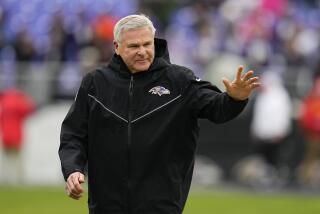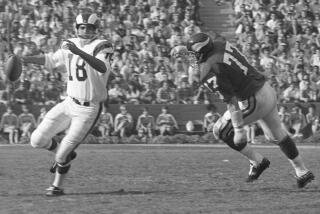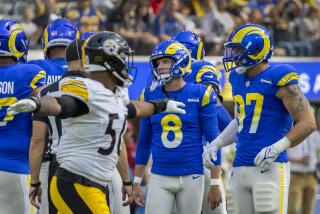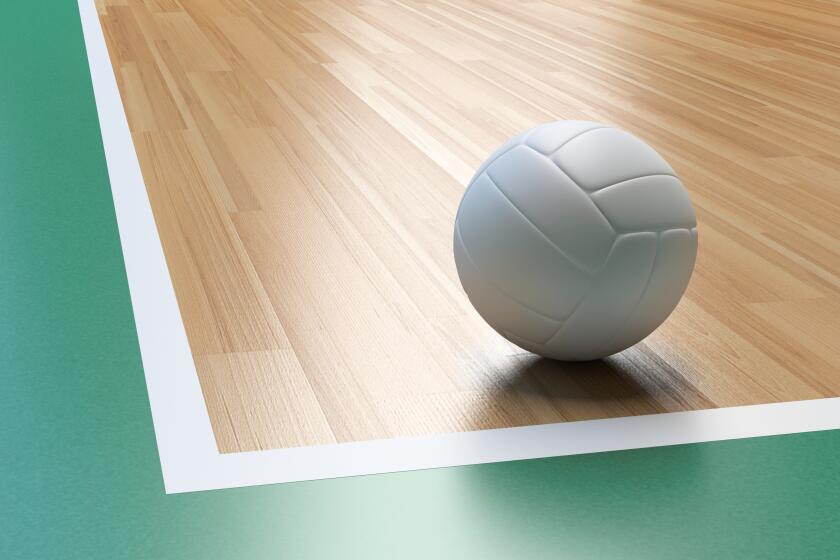MALAVASI’S MALAISE : After the Super Bowl Appearance, Life Wasn’t So Great
Ray Malavasi, 57, died last month of a heart attack on the seventh floor of an Orange County federal court building, the last place on Earth he wanted to be.
His final years and days were almost unreal ones, his life having become a litany of subpoenas, case loggings, depositions and depressions.
A Super Bowl coach with the Rams only eight years ago this month, Malavasi died alone, virtually penniless. He was separated from his wife, Mary, and separated, really, from reality.
Sadly, it was death that provided the quickest and most feasible halt to a runaway financial train that had swept him along to the final minute of his final day.
In August, 1986, Malavasi filed for bankruptcy, listing debts of $699,635.57 against assets of $190,092.
At the time of his death, at least six lawsuits were pending against him.
As his friends said later, Malavasi was a great football coach and a lousy businessman.
Malavasi collapsed in the court’s cafeteria Dec. 15, shortly before he was to testify on his own behalf in Orange County Superior Court case 454558, Matulik vs. Malavasi.
Malavasi had dreaded the Matulik case more than anything else.
Early that morning, as he had done often, Malavasi met Cliff Forkert, a close friend, for coffee at a Huntington Beach restaurant.
Forkert said he will never forget Malavasi’s last words to him: “ ‘Well Cliff, I’m going to go see what I can screw up today.’ ”
Matulik in this case was Father Martin E. Matulik, a priest from Denver and Malavasi’s one-time friend from the coach’s days as a Bronco scout in the 1960s.
“It’s silly to say now but he was Ray’s spiritual adviser,” Matulik’s attorney, Kristin Belko said.
According to Belko, Matulik had lent Malavasi his life savings, $25,000, to invest in two condominium projects in Palm Desert. Malavasi and Matulik had planned to retire there, she said.
But Malavasi, according to records, used Matulik’s money as security on another loan of $100,000 and then failed to make payments. The condominiums were soon lost through foreclosure, and Matulik’s money was gone.
In 1984, in Superior Court in Riverside, Matulik was awarded damages totaling $142,824.07, for Malavasi’s fraudulence in the sale of real estate.
Matulik was in court the day Malavasi died, still trying to recoup losses despite Malavasi’s bankruptcy proceedings.
“We just didn’t think he should be able to kiss it off,” Belko said of Malavasi’s debt.
Matulik was on the witness stand when Malavasi collapsed at 1:59 p.m. Malavasi died at Western Medical Center at 2:47.
Belko said that Matulik, who still lives in Denver, probably did not return a reporter’s phone calls because of poor health.
“The Father is not doing well,” she said. “The whole thing upsets him. It was more than the loss of money, it’s because of his friendship with Malavasi. He still almost weeps daily. It was a sad, emotional experience for him. He feels badly about it.
“He’s facing an uncertain future, precarious health, financial insolvency, not knowing how long he’ll live. Mr. Malavasi’s gone. That’s sad. He felt badly when Mr. Malavasi died.”
How Malavasi wound up in court that day and many others was not a great mystery to those who knew him. It seemed Malavasi in the business world was the proverbial fish out of water.
“I always tried to get him back into coaching,” said Jack Faulkner, the Rams’ director of operations who hired Malavasi as a scout with the Broncos in 1962. “I told him he was on the wrong side of the street. He was searching for some pie in the sky. Everything seemed to have a rainbow. Everything was get rich quick. And he took people with him.”
Malavasi, the only coach ever to take the Rams to a Super Bowl, was fired in 1982 by owner Georgia Frontiere after five seasons, an action from which Malavasi never fully recovered, friends say.
At Malavasi’s funeral, in fact, a scheduled eulogy by a Ram official was canceled at the last minute by members of Malavasi’s family. Bitterness remained until the end, even after.
Faulkner and others said that Malavasi had several chances to return to the NFL as an assistant coach after his firing but refused.
“He was very stubborn,” Faulkner said.
Malavasi wanted to return only as a head coach, an oddity in that he never seemed to quite fit the part.
His football acumen was unquestionable. He had been educated as a civil engineer at Mississippi State and possessed a sharp analytical mind.
Malavasi and friend Forkert designed the drainage system at Rams Park in Anaheim.
“Ray was probably, technically, the best of all the coaches at really knowing the game and what people could do,” former Ram guard Tom Mack said.
Malavasi was maybe the perfect defensive coordinator, a job he held with the Rams under Chuck Knox during the 1970s. When Knox left for the Buffalo Bills in 1977, Carroll Rosenbloom, then the Rams’ owner, hired back George Allen. But Allen was fired after two exhibition games, and Malavasi was promoted to succeed him.
Still, he never seemed comfortable as head coach. He lacked the public relations flair needed to sell football as entertainment. Like him or not, what you saw in Malavasi was what you got. There was no personality filter, no pretense. He could be irascible with reporters, or even with the host of his own radio show. Malavasi was an equal opportunity curmudgeon.
He chewed tobacco and didn’t care where he spat. His clothes were rumpled and his gray-streaked hair waged constant war with the wind.
Malavasi also was a little overweight, and his shirttail never quite found its way into the back of his pants.
One didn’t normally speak of Tom Landry and Ray Malavasi in the same breath.
Yet, for all the shortcomings of image, for all the times Malavasi cursed reporters, for all the pressure and the antacid tablets he accepted and consumed, it seemed that being a head coach was all he ever wanted.
And in the end, it was the job he couldn’t get. Malavasi coached briefly in the United States Football League, with the Oakland Invaders and the L.A. Express.
But it never satisfied him. He sought a microwave-quick return to the top, to feel what he had felt with the Rams in the Super Bowl season of 1979.
And if he was not to be allowed the chance in football, he figured, he would find another way, even if it meant impossible journeys over the business rainbow.
“I don’t think money meant that much to him,” Bob O’Connor, another close friend, said. “If you looked at his apartment you wouldn’t think so. He was just looking for success. He was looking for anything, even if it meant leading the United Crusade for no pay.”
Unfortunately, that was all too true.
Malavasi had always dabbled in business, even in his head coaching days. But at least those failures could be softened with a steady, if not totally secure, weekly coaching income.
The world outside offered no such comfort. Malavasi failed not because of lack of effort. He had more than enough energy. His problem, it seemed, was having a hand in everything but a foothold on little.
His high visibility as a one-time coach of the Rams made it easy for him to find financial backers and get credit from bankers. He might have used people, and in turn, some might have used him.
“I honestly believe that what happened to Ray was that an awful lot of people he did business with took advantage of him,” Malavasi’s attorney, James Allen, said. “He was a good-hearted man. He believed a handshake was a bond.”
Malavasi no doubt shook a lot of hands, but almost everything he touched turned to dust.
Malavasi had restaurants that opened and closed, real estate deals that failed. There were oil deals in Texas, searches for gold in Mexico. He schemed and dreamed and most often lost. He once sold fitness machines, fire extinguishers, T-shirts and even football to Australia.
Last summer, he and O’Connor, a former athletic director at Pierce College in Woodland Hills, toured Europe with an Australian national football team, hoping to spark interest on another continent.
Malavasi was also collaborating with O’Connor on a technical book about football. O’Connor said it would not have sold well.
“There was no money in the book,” he said. “It would have been sold only as a coaches’ book. If you can sell five or six thousand, you’re lucky.”
Luck wasn’t something that shadowed Malavasi.
In 1985, Malavasi even tried his hand at sports agentry, working as a West Coast representative for Pro Sports Management of Cincinnati.
“We sought him out because of his reputation in football,” Harrison Green of Pro Sports Management said.
But that didn’t work out.
“Ray didn’t have time to follow through, and we had other people out there,” Green said.
Malavasi once had grandiose plans of starting an International Football League. Yet, he also toiled in the holography business, producing artwork for credit cards.
In the early 1980s, Malavasi and former Ram attorney James Perry went into fire extinguisher sales, a venture Perry still regrets. Perry said that when the business failed, he was left to pay off more than $50,000 in expenses.
“He basically hung me out to dry,” Perry said. “He had no assets, so they came after me. Honestly, I’m still trying to recover financially. It ruined my credit. Banks filed suit against me. I had to refinance my house, which tripled my mortgage payment, which is nothing compared with how much crap I took from my wife.”
Perry, still married, said he and Malavasi had not spoken in five years.
“He was always looking for a pot of gold,” Perry said of Malavasi. “He was vulnerable, gullible. People used him. He used his name to sign people up. . . . There’s a whole bunch of people in the same boat.”
Malavasi’s debts, detailed in bankruptcy papers filed in 1986, read like a who’s who’s of West Coast banking:
--Heritage Bank, Costa Mesa, $130,000.
--Security Pacific National Bank, $68,000.
--Bank of America (VISA), $7,226
--Huntington National Bank, $146,312.20.
--Orange City Bank, $10,000.
--Liberty National Bank, $30,000.
And then there were the private debts:
--American Airlines, $1,197.58.
--Father Martin E. Matulik, $142,824.07.
--Sandra Jenkins, $15,663.76.
And on and on.
Jenkins, according to her attorney, who asked that his name not be used, had in 1982 invested money in a publication called RamScore, a sports magazine that Malavasi might have been only peripherally involved with, perhaps lending only his recognizable name to the project.
Still, the magazine failed, and Jenkins lost her entire investment.
And Jenkins, like the others, went looking for Malavasi.
Although his wife, Mary Malavasi, and members of the family declined to be interviewed for this story, friends said that Malavasi was deeply sorry about his mistakes and was constantly trying to find a way to make the money back.
Forkert had known Malavasi since he arrived with the Rams as Chuck Knox’s assistant in 1973.
“He never blamed anyone for anything,” Forkert said. “He just took it all in stride. He was working hard, bluntly, to get out of debt. He should be remembered by a lot of people.”
Malavasi lived with Forkert for a period around 1985. They fished together, cooked together, planned together, schemed together.
Forkert, himself, had once joined Malavasi in the fitness exercise machine business. “It went belly up,” Forkert said.
Malavasi, for sure, had his problems. He was at times temperamental, stubborn and, according to friends, had long battled an alcohol problem.
Malavasi has been portrayed both as victim and villain, a man who unwisely ventured into a world he knew little about.
Few would argue his lack of business savvy. But to friends, Ray was just ol’ Ray, a guy to cook a steak with.
“He was just a hell of a guy,” Forkert said. “I had a lot of fun with him. Yes I did. You know, you get a name like head coach and everyone gets in line to sue you. There are lawyers waiting around. It seems like he was too big-hearted.”
Said O’Connor: “He was a gruff old guy, but he really had a good soul.”
For others, like Father Matulik, the memories of Malavasi won’t be so pleasant.
Matulik’s money, and that of all the others, is probably lost forever.
“It’s essentially all over,” Malavasi’s attorney, Allen, said. “There’s not much they can do to him. The biggest mystery to me is why he was never given, by the powers that be, an opportunity to coach again in the NFL. He was a hell of a football coach. He’s the only one ever to take the Rams to the Super Bowl. The NFL abandoned him.”
Faulkner said that Malavasi was scheduled to have a heart checkup shortly after the day he died. Malavasi had had coronary bypass surgery in 1979.
Malavasi, as it was, never had much luck with timing.
“It’s a sad ending for a guy that still had such a future in the game,” Faulkner said.
Belko, Matulik’s lawyer, believes that had Malavasi lived on Dec. 15 and testified in court, he would have apologized to his priest friend.
Malavasi was not mean, she said, only misguided.
“I think he hoped to make things work out for them,” she said. “It was a physical strain for the Father to come out here to testify. It was terribly sad; the financial matter, the loss of a friend, never meeting face to face, never saying I’m sorry.
“I think Ray would have come into court and said, ‘I’m sorry.’ It’s sad to have him go without expressing that.”
More to Read
Go beyond the scoreboard
Get the latest on L.A.'s teams in the daily Sports Report newsletter.
You may occasionally receive promotional content from the Los Angeles Times.











